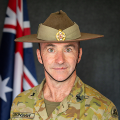Ralph Honner: Kokoda Hero is a timely book as we remember the 81st anniversary of the battle of Isurava (26-31 Aug 1942). The related Cove animated video “Kokoda” gives an insightful picture of the battlefield’s progression to watch alongside this review.
Chaplain Matthew Stuart, when we served together at Kapooka, inspired my curiosity about Kokoda when he said we look back to Australia’s Gallipoli Campaign as the founding moment of our Anzac heritage, rightly so, but we have just as much or more to learn from Kokoda.
Prime Minister Paul Keating had earlier added to the mythmaking of Kokoda when he stated Kokoda should rank higher than Gallipoli in our consciousness because Diggers more directly “died in defence of Australia”. Kapooka chaplains use a video of the Battle of Isurava and Lieutenant Colonel Ralph Honner’s address to the 39th Battalion to illustrate ADF values.
My grandfather Sidney Humphreys (2 May 1910-1980s) also served in the Middle East and New Guinea, though he was actually home in Australia marrying my Nana 81 years ago at the time of Isurava and did not get back to PNG till later. This all inspired me to turn to Peter Brune’s biography of Ralph Honner: Kokoda Hero, and I returned to it last year as I wrote my leadership philosophy for All Corps Major Course, and then again this year as I reflected on the context of Pop’s WWII service.
The book details the family background, life (1904-1994), and military service (1936-1944) of Lieutenant Colonel Ralph Hyacinth (Jump) Honner, DCO, MC. We read of his great grandparents and grandparents emigrating from Ireland, Catholic schooling during WWI, training and work as a teacher, training as a lawyer, marriage to Marjory, operational service in the Middle East and PNG, rehabilitation from war wounds, staff role in Directorate of Military Training where he worked on creating training manuals, work as Chairman of a War Pensions Assessment Appeal Tribunal (1944-68), contribution to the Catholic Church and the Liberal Party including President of the NSW Branch (1961-63), Ambassadorship to Ireland (1968-1972), and retirement.
He had also served in the Army Reserve which was then known as the Citizen Forces (1924-27), though this is curiously not mentioned.
Ralph joined the Western Desert campaign as a Captain in the 2/11th Battalion. Brune describes how he learned valuable lessons while fighting at Bardia, Tobruk and Derna, (especially offensive infantry tactics and artillery coordination) then Greece (which was a fighting withdrawal, for which he was later awarded the Military Cross) and Crete (more a set piece defence). These tactics, as Brune explains, were important lessons for New Guinea.
The highlight of the book, and Honner’s career, was undoubtedly his leadership of the 39th Battalion in the fighting withdrawal on the Kokoda Trail, especially the ‘defining moment’ of Battle of Isurava (26-31 Aug 1942) and later the ‘ultimate triumph’ at the Battle of Buna-Gona (16 Nov 42-22 Jan 43).
Being awarded the Distinguished Service Order after Gona recognised his outstanding moral courage and creative intellect. I was fascinated to read of the influence of a commander’s leadership - building on morale, the utilisation of a strategic fighting withdrawal against overwhelming numbers, and offensive movement with combined artillery support. I also enjoyed reading of Padre Norbert ‘Nobby’ Earl’s support of his commander and the battalion, including a rescue and care of a battle casualty.
There were also tragic action review lessons to consider from poor intelligence, lack of communication, pressure of quick results, and futile attacks without reconnaissance. Brune also identifies apparent disloyalty and self-service from higher command, epitomised by General Blamey’s Koitaki diatribe where he criticized the Maroubra Force’s withdrawal as defeat. In contrast, Honner likened the tactics to the bravery and sacrifice of Thermopylae delaying a superior-sized army.
Honner consistently seemed to be able to bring the best out of his troops, despite a lack of training and the effects of battle weariness. He later commented: “It’s a confidence business; all war is a confidence business. If there isn’t confidence in your mates and your leadership, and your weapons and your training, you’re not good soldiers” (p.60).
Honner’s last command was of the 2/14th Battalion, until he was shot leading a recce advancing from Wampun on the 4th of October, 1943. The respect of his own troops was also held by the opposing force, amazingly shown years later when amid the formality of his funeral, a Japanese veteran approached the coffin, stiffly bowed in respect, and bowed again while offering a letter of condolence to his family.
Honner’s biographer Peter Brune is a best-selling Australian military author who also authored Our Great Hearted Men about 100 day battles of Australian Corps in WWI and how they learned to incorporate coordinated firepower, Descent into Hell on Singapore, Changi and the Thai-Burma Railway, and A Bastard of a Place: The Australians in Papua about the tactical battles and political manoeuvring of Papua battles.
He has also co-authored books such as Valiant for Truth: The Life of Chester Wilmot, War Correspondent, with Neil McDonald. Brune offers outstanding historiography, drawing on interviews alongside War Memorial documents and identifying failures of tactics and strategy as well as stories of chivalry and strategic brilliance.
The copy of my book is now in the hands of my young adult children with encouragement to digest the lessons of Kokoda’s story that are relevant for soldiers, commanders, and leaders in non-military spheres.
An earlier version of this review was published in Grounded Curiosity (Jan 30, 2022)









